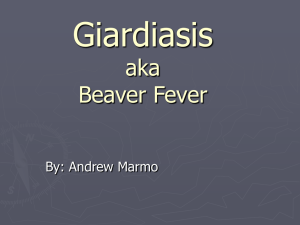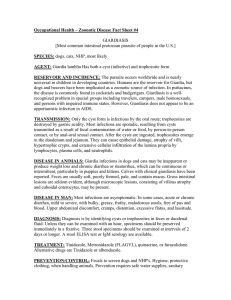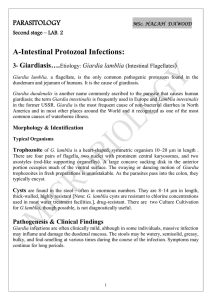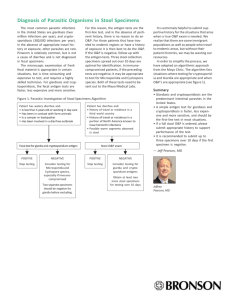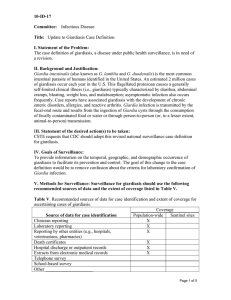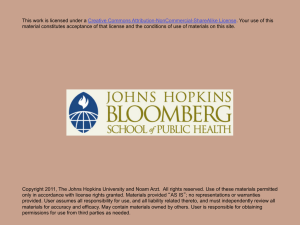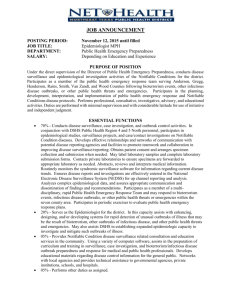State based data collection of cases of Giardiasis is essential... recognition of potential clusters of disease that are distributed across... 01-ID-08
advertisement
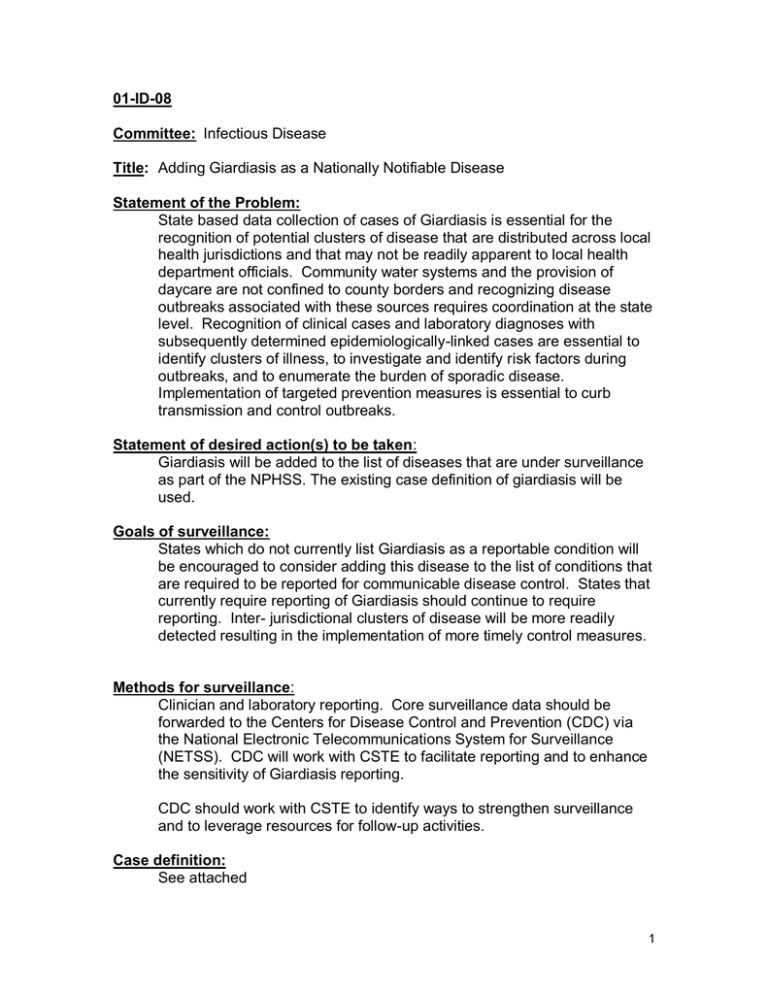
01-ID-08 Committee: Infectious Disease Title: Adding Giardiasis as a Nationally Notifiable Disease Statement of the Problem: State based data collection of cases of Giardiasis is essential for the recognition of potential clusters of disease that are distributed across local health jurisdictions and that may not be readily apparent to local health department officials. Community water systems and the provision of daycare are not confined to county borders and recognizing disease outbreaks associated with these sources requires coordination at the state level. Recognition of clinical cases and laboratory diagnoses with subsequently determined epidemiologically-linked cases are essential to identify clusters of illness, to investigate and identify risk factors during outbreaks, and to enumerate the burden of sporadic disease. Implementation of targeted prevention measures is essential to curb transmission and control outbreaks. Statement of desired action(s) to be taken: Giardiasis will be added to the list of diseases that are under surveillance as part of the NPHSS. The existing case definition of giardiasis will be used. Goals of surveillance: States which do not currently list Giardiasis as a reportable condition will be encouraged to consider adding this disease to the list of conditions that are required to be reported for communicable disease control. States that currently require reporting of Giardiasis should continue to require reporting. Inter- jurisdictional clusters of disease will be more readily detected resulting in the implementation of more timely control measures. Methods for surveillance: Clinician and laboratory reporting. Core surveillance data should be forwarded to the Centers for Disease Control and Prevention (CDC) via the National Electronic Telecommunications System for Surveillance (NETSS). CDC will work with CSTE to facilitate reporting and to enhance the sensitivity of Giardiasis reporting. CDC should work with CSTE to identify ways to strengthen surveillance and to leverage resources for follow-up activities. Case definition: See attached 1 Period of Surveillance: Indefinite Background and Justification: Giardia intestinalis (lamblia) is the most commonly identified parasitic pathogen in the United States, causing gastrointestinal infection ranging from asymptomatic disease to illness characterized by severe diarrhea and dehydration. Giardiasis occurs when cysts are ingested from fecally contaminated food or water and from person-to person transmission. Giardia cysts can be excreted in the stool intermittently for weeks or months, and because the infectious dose is low, (~10cysts) there is a protracted period of communicability. Giardiasis has been well documented as a leading cause of waterborne and day-care center outbreaks of diarrhea and more recently has been recognized as the etiologic agent in recreational water outbreaks. The emergence of Giardiasis as a widespread and debilitating disease has been acknowledged in the literature yet the magnitude of unrecognized outbreaks and sporadic cases and the associated morbidity remain unknown. In 1992 CSTE assigned Giardiasis an event code in the National Electronic Telecommunications System for Surveillance that enabled states to voluntarily report surveillance data to CDC1. Since 1992 the number of states reporting Giardiasis to CDC has risen from 23 to 43. Over the years some states have added Giardiasis as a reportable condition while other states have dropped it. There were 27,778 cases voluntarily reported to CDC in 1991. Giardiasis has been reported as the third highest incident cause of gastroenteritis in the US with an estimated 2,000,000 cases annually behind Norwalk/Astro/Rotavirus and Campylobacter infections (Mead et al, EID 1999). This policy resolution requires minimal enhancements to the existing communicable disease surveillance and outbreak response system operating at the state and local level. Less than 10 states will need to establish Giardiasis as a reportable condition. The infrastructure to track and report this parasitic condition already exists via NETSS, thus minimizing the cost to these states and to CDC in order to achieve reporting status in all 50 states and US territories. Local health departments will need to notifiy health providers and clinical laboratories to report all cases meeting the case definition as they currently do with other notifiable conditions. State and local health departments will need to evaluate case reports, recognize and respond to outbreaks, and publish statistics in their annual report. The infrastructure to conduct these public health functions exists and implementation of this policy resolution will not 2 require great changes in the state’s communicable disease surveillance system. Identification of cases and clusters will allow prevention measures to be implemented in outbreaks associated with day-care centers, with drinking water, and with recreational water exposures, which in turn, will serve to reduce the number of cases attributed to transmission of this highly communicable pathogen. In addition, recognition of sporadic cases of this debilitating disease will allow for proper medical management and will serve to prevent the severe complications that can accompany this disease. Coordination: Agencies for Response: Dr. Jeffrey P. Koplan, MD, MPH Director Centers for Disease Control and Prevention 1600 Clifton Road, NE Mailstop D-14 Atlanta, GA 30333 Authors: Jerry Gibson MD, MPH State Epidemiologist South Carolina Department of Health and Environmen tal Control 803-898-0861 gibsonjj@columb60.dhec.state.sc.us Lauren Ball, DO, MPH Medical Epidemiologist Division of Parasitic Diseases, NCID, CDC 770-488-7769 LHB8@cdc.gov References: Mead PS, Slutsker l, Dietz v, McCaig LF,. Bresee JS, Shapiro C, Griffin PM, and Tauxe RV. Food related illnesses and death in the United States. Emerg Infect Dis [serial online] 1999 Sept-Oct ; 5 (5). Available from: URL: http://www.cdc.gov/ncidod/EID/eid.htm 3 Giardiasis Clinical Description An illness caused by the protozoan Giardia lamblia and characterized by diarrhea, abdominal cramps, bloating, weight loss, or malabsorption. Infected persons may be asymptomatic. Laboratory criteria for diagnosis Demonstration of G. lamblia cysts in stool, or Demonstration of G. lamblia trophozoites in stool, duodenal fluid, or small bowel biopsy, or Demonstration of G. lamblia antigen in stool by a specific immunodiagnostic such as enzyme-linked immunosorbent assay (ELISA) Case classification Confirmed, symptomatic: A laboratory confirmed case associated with one or more of the symptoms described above Confirmed, asymptomatic: A laboratory confirmed case associated with none of the symptoms described above 4
